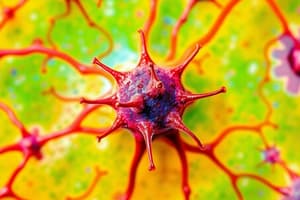Podcast
Questions and Answers
What are cutaneous receptors?
What are cutaneous receptors?
- Nerves in the skin
- Skin loaded with various types of receptors (correct)
- Muscles that sense temperature
- None of the above
What type of stimuli do Meissner corpuscles respond to?
What type of stimuli do Meissner corpuscles respond to?
Flutter/stroking (light touch)
Where are Pacinian corpuscles located?
Where are Pacinian corpuscles located?
Deep layers of skin
Ruffini endings adapt rapidly.
Ruffini endings adapt rapidly.
What type of stimuli do Merkel cells respond to?
What type of stimuli do Merkel cells respond to?
What do free nerve endings respond to?
What do free nerve endings respond to?
What are nociceptors?
What are nociceptors?
Cold temperature receptors are active below _____°C.
Cold temperature receptors are active below _____°C.
What is transduction in sensory receptors?
What is transduction in sensory receptors?
Slowly adapting receptors trigger nerve impulses only at the onset of a stimulus.
Slowly adapting receptors trigger nerve impulses only at the onset of a stimulus.
What kind of response do rapidly adapting receptors provide?
What kind of response do rapidly adapting receptors provide?
What does the intensity of a stimulus affect?
What does the intensity of a stimulus affect?
Match transduction types with their descriptions:
Match transduction types with their descriptions:
What determines the modality of a stimulus?
What determines the modality of a stimulus?
All receptors have the same areas of sensitivity.
All receptors have the same areas of sensitivity.
Flashcards
Cutaneous Receptors
Cutaneous Receptors
Specialized sensory structures in the skin that detect various stimuli, such as touch, pressure, temperature, and pain.
Meissner Corpuscle
Meissner Corpuscle
A rapidly adapting receptor located in the superficial skin layers, sensitive to flutter and light touch. It fires only at the onset and offset of the stimulus.
Pacinian Corpuscle
Pacinian Corpuscle
A rapidly adapting receptor found in deep skin layers, responding to vibration. It has a similar structure to Meissner but fires only during stimulus changes.
Ruffini Ending
Ruffini Ending
Signup and view all the flashcards
Merkel Cell
Merkel Cell
Signup and view all the flashcards
Free Nerve Endings
Free Nerve Endings
Signup and view all the flashcards
Nociceptors
Nociceptors
Signup and view all the flashcards
Temperature Receptors
Temperature Receptors
Signup and view all the flashcards
Transduction
Transduction
Signup and view all the flashcards
Slowly Adapting Receptor
Slowly Adapting Receptor
Signup and view all the flashcards
Rapidly Adapting Receptor
Rapidly Adapting Receptor
Signup and view all the flashcards
Transduction Timing
Transduction Timing
Signup and view all the flashcards
Transduction Intensity
Transduction Intensity
Signup and view all the flashcards
Transduction Modality
Transduction Modality
Signup and view all the flashcards
Transduction Location
Transduction Location
Signup and view all the flashcards
Study Notes
Cutaneous Receptors Overview
- Skin contains various types of receptors, each responding to different stimuli.
- Receptors are innervated by axons.
Meissner Corpuscle
- Sensitive to flutter and light touch.
- Located in the superficial layers of skin.
- Composed of nerve endings enclosed in connective tissue.
- Rapidly adapting, firing only during stimulus onset and offset.
Pacinian Corpuscle
- Responsive to vibration.
- Found in the deep layers of skin.
- Like Meissner, consists of encapsulated nerve endings.
- Rapidly adapting receptor.
Ruffini Ending/Corpuscle
- Detects skin stretching.
- Located in the deep skin layers.
- Consists of enlarged nerve endings.
- Slowly adapting, continuing to fire as long as the stimulus persists.
Merkel Cells
- Respond to steady pressure and texture.
- Situated in the superficial layers of skin.
- Composed of enlarged nerve endings.
- Slowly adapting receptor, providing ongoing stimulus information.
Free Nerve Endings
- Respond to temperature, pain, itch, and hair follicle movement.
- Found around hair roots and beneath the skin surface.
- Comprised of unmyelinated nerve endings.
- Exhibit variable adaptation characteristics.
Nociceptors
- Specialized receptors that respond to noxious stimuli that can damage tissue (chemical, mechanical, thermal).
- Utilized by free nerve endings.
- Activate reflexive responses via spinal cord or send signals to the cerebral cortex for conscious sensation of pain or itch.
Temperature Receptors
- Cold receptors are activated below 37°C; warm receptors function between 37°-45°C.
- Adapt slowly between 20°-40°C, but nociceptors recognize pain outside this range.
- Chemicals (e.g., menthol, capsaicin) can influence temperature receptors.
Transduction Process
- Converts sensory stimuli into action potentials.
- Triggered by membrane stretch opening mechanical gateways for ion influx (e.g., Na+).
- Action potential generated upon reaching the threshold.
Slowly Adapting Receptors
- Trigger continuous nerve impulses as long as the stimulus persists.
- Examples include Merkel cells and Ruffini endings.
Rapidly Adapting Receptors
- Fire briefly during the onset and/or offset of a stimulus.
- Includes Pacinian and Meissner corpuscles.
Transduction Timing
- Slow transduction leads to many action potentials throughout the stimulus duration.
- Rapid transduction is characterized by concentrated bursts of action potentials during changes in the stimulus.
Transduction Intensity
- Higher stimulus intensity correlates with increased frequency of action potentials.
Transduction Modality
- Refers to the type of stimulus, determined by skin indentation and stimulus frequency.
- Specific receptors fire according to their strengths, sending appropriate action potentials.
Transduction Location
- Different receptors exhibit overlapping and variable sensitivity areas.
- Meissner (rapidly adapting) and Merkel (slowly adapting) have small, specific sensory fields.
- Pacinian (rapidly adapting) and Ruffini (slowly adapting) possess larger sensory fields.
Studying That Suits You
Use AI to generate personalized quizzes and flashcards to suit your learning preferences.




